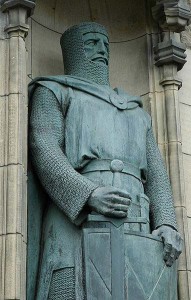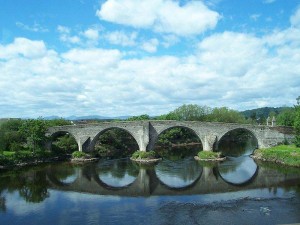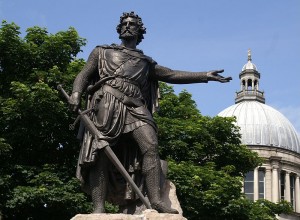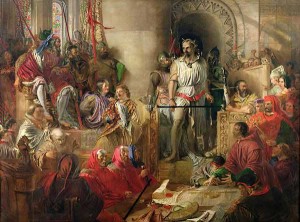| William Wallace | |
|---|---|
 |
|
| Scottish Military Hero | |
| Born | c. 1279 Elderslie, Renfrewshire, Scotland |
| Died | Hanged, drawn and quartered on Aug. 23, 1305 Smithfield, London, Middlesex, England |
| Source of Fame | Commander in the Scottish Wars of Independence |
William Wallace (c. 1270-1305) was a Scottish country gentleman who led his nation in several battles against the English. Although he was a brilliant military strategist, he was eventually captured and executed in London. After his death, Wallace became one of the iconic figures of Scottish nationalism and has been greatly celebrated in both literature and film.
Early Life
Wallace was born c. 1270 near Kilmarnock. Not much can be said with certainty about Wallace’s childhood, as almost no contemporary records of this period have survived. According to a chronicler writing two centuries later, Wallace was one of three brothers, the others named John and Malcolm. He was educated by two of his uncles, who were also clergymen, and was taught Latin and French.
In 1290, a conflict emerged about the right of succession to the kingship of Scotland. Edward came forward. He entered Scotland at the head of a great army and considered himself the lord of a vassal state. After hearing each candidate’s claim to the throne, Edward chose John Balliol to serve as a puppet ruler.
In the spring, Balliol announced that he would no longer pay homage to the English king, which prompted Edward to sack the border town of Berwick-upon-Tweed. He continued with victory at the Battle of Dunbar, and by the summer Balliol was compelled to renounce his throne. In August, Edward came to Berwick and two thousand local leaders paid him homage. Edward ultimately brought Scotland under his own rule.
Emergence as a Military Leader
 In 1297, Wallace began what would become a definitive campaign against Edward. A petty dispute about the right to catch fish grew into a serious conflict during which Wallace killed two English soldiers. A warrant for his arrest was issued. Wallace resented the English, because his father had been killed by Englishmen in 1291.
In 1297, Wallace began what would become a definitive campaign against Edward. A petty dispute about the right to catch fish grew into a serious conflict during which Wallace killed two English soldiers. A warrant for his arrest was issued. Wallace resented the English, because his father had been killed by Englishmen in 1291.
Determined to avenge his father’s death, he was victorious in the battles of Loudoun Hill and Ayr. In May, Wallace won a further victory at Scone, fighting alongside Sir William Douglas. Despite these triumphs, in the end, the Scottish nobility agreed on terms with Edward in July, and the following month Wallace went to Sterling to meet up with the army of Andrew de Moray who was leading another rebellion.
The Battle of Stirling Bridge
On September 11, 1297, Wallace won his most significant military victory. The Scottish rebels at Stirling Bridge were outnumbered by their English adversaries and de Moray and Wallace realized the strategic importance of Stirling bridge. Because of its narrowness, the English could not cross it in wide formation, which would have allowed the Scottish rebels to attack from a distance as the English attempted to advance.
 As English soldiers realized what was happening they decided to retreat only to be driven again by the Scottish who were continuing to advance from farther back. Many men were now on the bridge, and so it collapsed drowning many of the Englishmen.
As English soldiers realized what was happening they decided to retreat only to be driven again by the Scottish who were continuing to advance from farther back. Many men were now on the bridge, and so it collapsed drowning many of the Englishmen.
A portion of the Scottish army crossed the river a small distance upstream, which allowed them to mount a pincer movement. This strategy forced the English soldiers back to the river.
The defeat over and English armies gave the Scottish army more confidence. Wallace was knighted for his bravery, and in March 1297 he was made the Guardian of Scotland. De Moray was not so lucky. He eventually passed away three months later from wounds he had received in battle. Wallace would now have to lead the campaign alone.
The Battle of Falkirk
 Although the Scottish fighters gained an advantage after the Battle at Stirling Bridge, the tide of the war turned the following year. In June 1298, Edward’s men crossed into Scotland at Roxburgh and succeeded in taking back a few castles. They took a considerable amount of treasure. However, this did not draw William back to the battlefield. Errors in supplies and organization left the English with scarce food and particularly low morale.
Although the Scottish fighters gained an advantage after the Battle at Stirling Bridge, the tide of the war turned the following year. In June 1298, Edward’s men crossed into Scotland at Roxburgh and succeeded in taking back a few castles. They took a considerable amount of treasure. However, this did not draw William back to the battlefield. Errors in supplies and organization left the English with scarce food and particularly low morale.
Men with spears were arranged in four roughly circular groups, each one guarded by an circular wall made of wooden stakes. Despite the strength of these defenses, the English gained an advantage by mounting a rapid cavalry attack. This caused panic in the ranks of the Scottish archers and many of Wallace’s knights retreated. Meanwhile, Edward’s infantry hurled spears stones, arrows and bolts at the Scottish soldiers.
After a short time, gaps opened up in the Scottish defenses, and it became clear that the English to needed to suppress the resistance which remained. Wallace’s reputation as a military strategist was damaged because he lost many of his soldiers. By 1298, Wallace gave up his position as the Guardian of John Comyn and Robert Bruce. Bruce made peace with Edward four years later, but Wallace, who visited France at this time, refused.
Wallace’s Death and Legacy
 William Wallace remained a free man until the spring of 1305. In May, he was taken prisoner by Sir John de Menteith outside Glasgowl. He was Scottish but maintained allegiance to Edward. Wallace was accused of treason because he had never submitted to Edward’s rule. The outcome of his trial was clear. Wallace was condemned to death.
William Wallace remained a free man until the spring of 1305. In May, he was taken prisoner by Sir John de Menteith outside Glasgowl. He was Scottish but maintained allegiance to Edward. Wallace was accused of treason because he had never submitted to Edward’s rule. The outcome of his trial was clear. Wallace was condemned to death.
On August 23, 1305, Edward I had William Wallace drawn, quartered, and then hanged. In the end, his head was placed on a pike at London Bridge, and his severed limbs were showcased in four cities in Scotland and northern England. In 1869, a William Wallace Monument was built at Stirling Bridge, and today the life of William Wallace is celebrated as a symbol of Scottish independence.